When you edit materials and maps, these appear in the active View as “nodes” that you can wire together.
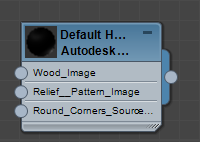
Example of a material node
A node has several components:
- The title bar shows a small preview icon, followed by the name of the material or map, and then the material or map type.
- Below the title bar are slots that show components of the material or map.
By default, the Slate Material Editor displays only slots that you can map.
- To the left side of each slot, a circular socket is for input. You can use these, for example, to wire a map to the component. See Wiring Nodes.
- To the right of the entire node, a circular socket is for output. You can use this to wire a map to a material or a material to an object. See Wiring Nodes and To apply a material to objects in the scene.
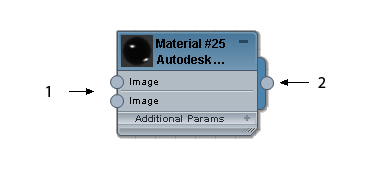
Input and output sockets
1. Input sockets to the material’s slots
2. Output socket for the entire material
You can collapse a node to hide its slots, or expand it to show the slots. You can also resize a node horizontally, so the slot names are easier to read.
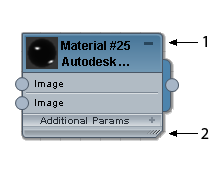
Node display controls
1. Collapse/expand the node.
2. Resize the node.
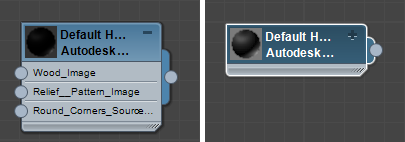
Left: An expanded node (the expand/collapse icon is a minus sign)
Right: The same node after collapsing it (the expand/collapse icon changes to a plus sign)

Left: An expanded node
Right: The same node after resizing it by dragging the resize icon
You can enlarge the preview in a node’s title bar by double-clicking the preview. To reduce the preview, double-click the preview again.
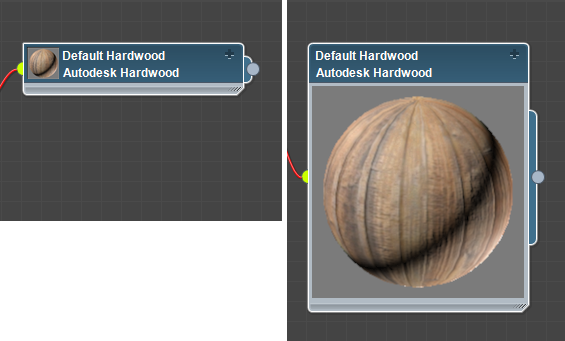
Left: A node with the default preview size
Right: The preview has been enlarged by double-clicking it. (A second double-click returns to the small size.)
While a node's parameters are displayed in the Parameter Editor, in the active View it appears with a dashed border.

Highlight for a node displayed in the Parameter Editor
Indicators for Show Map In Viewport
If you turn on Show Shaded Map In Viewport or Show Realistic Map In Viewport for a material or a map, a red diagonal shape appears in the title bar of the material or map node, to show that this option is active. For more information about this option, see Viewport Display of Materials.
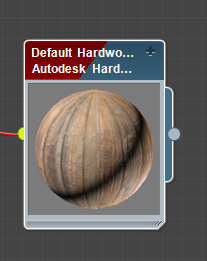
Red flag in title bar shows that Show Map In Viewport has been turned on.
When Show Map is on, the Navigator also uses a diagonal red shape to indicate this, and so does the material or map entry in the Material/Map Browser.
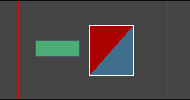
Navigator display of a material with Show Map In Viewport turned on

Material/Map Browser entry for a material with Show Map In Viewport turned on
Selecting, Moving, and Laying Out Nodes
When a node is selected in the View, it shows a white border and the background, including the title bar, is darker. When it is not selected, the border is gray and the background is lighter.
![]() To select a node, make sure the Select tool is active, then click the node. To select multiple nodes, use
To select a node, make sure the Select tool is active, then click the node. To select multiple nodes, use  +click (
+click ( +click removes a node from the current selection), or drag a selection rectangle around the nodes. The Select menu has options for modifying the current selection.
+click removes a node from the current selection), or drag a selection rectangle around the nodes. The Select menu has options for modifying the current selection.
![]() To deselect nodes, make sure the Select tool is active, then click a blank area of the View.
To deselect nodes, make sure the Select tool is active, then click a blank area of the View.
Dragging a selected node moves it in the View.
 +dragging a node clones that node.
+dragging a node clones that node.  +
+ +dragging a node clones the node and all the node’s children. These cloning methods also work for multiple selections.
+dragging a node clones the node and all the node’s children. These cloning methods also work for multiple selections.
You can use these options to move nodes and lay them out:
-
 Move Children (Options menu
Move Children (Options menu  Move Children) When this is on, moving a node moves its child nodes along with it. When it is off, moving a node moves only that node.
Move Children) When this is on, moving a node moves its child nodes along with it. When it is off, moving a node moves only that node. Temporary shortcut:
 +
+ +drag moves a node with its children, but doesn’t turn on the Move Children toggle.
+drag moves a node with its children, but doesn’t turn on the Move Children toggle. -

 Layout All - Vertical and Layout All - Horizontal (View menu
Layout All - Vertical and Layout All - Horizontal (View menu  Lay Out All) Arrange all nodes in an automatic layout, along either a vertical or a horizontal axis.
Lay Out All) Arrange all nodes in an automatic layout, along either a vertical or a horizontal axis. -
 Layout Children (View menu
Layout Children (View menu  Lay Out Children) Automatically lays out the children of the selected node.
Lay Out Children) Automatically lays out the children of the selected node.
Hot and Cool Materials
A material node is "hot" when the material in the node is assigned to one or more surfaces in the scene. When you use the Slate Material Editor to adjust a hot material node, the material in the scene changes at the same time.
In the title bar of the node, the corners of the material preview indicate whether the material is a hot material:
-
 No triangles: The material is not used in the scene.
No triangles: The material is not used in the scene. -
 Outlined white triangles: The material is hot. In other words, it is instanced in the scene. Changes you make to the material in the Slate Material Editor will change the material displayed in the scene.
Outlined white triangles: The material is hot. In other words, it is instanced in the scene. Changes you make to the material in the Slate Material Editor will change the material displayed in the scene. -
 Solid white triangles: The material is not only hot, but is applied to the currently selected object.
Solid white triangles: The material is not only hot, but is applied to the currently selected object.
A material is "cool" if it is not applied to any object in the scene.
To make a hot material node cool, clone it by using  +drag or
+drag or  +
+ +drag. This makes a copy of the material (or of the material plus its maps) that is not used in the scene.
+drag. This makes a copy of the material (or of the material plus its maps) that is not used in the scene.
Procedures
To place a material or map node in the active View:
- Find the material or map you want on the Material Map Browser, then drag its name or icon from the Material Pool into the active View, or simply double-click the name or icon.
To give a material or map a different name, do one of the following:
- In the Material/Map Browser
 Scene Materials group, or any library, right-click the name of the material and choose Rename.
Scene Materials group, or any library, right-click the name of the material and choose Rename. - In the active View, right-click the material node, and choose Rename.
3ds Max opens a Rename dialog, which lets you enter a new name for the material.
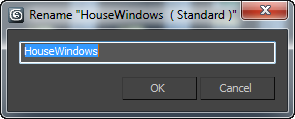
The name of a material can contain spaces, numbers, and special characters.
To edit a material:
- Drag the material from the Material/Map Browser
 Scene Materials group (or any library) to the active View.
Scene Materials group (or any library) to the active View. 3ds Max opens an Instance (Copy) dialog. Choose Instance, and then click OK.
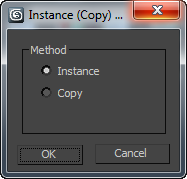
To edit the settings of a material or map:
- Double-click the node whose settings you want to edit.
The rollouts for the material or map appear in the Parameter Editor, where you can change settings.
To create a new material:
- Drag the material from the Material/Map Browser
 Material group to the active View, or double-click the Browser entry.
Material group to the active View, or double-click the Browser entry. 3ds Max places a node for the material in the active View.
Tip: When you create a new material, it is a good idea to rename it immediately.
To make a copy of a material:
- Drag the material from the Material/Map Browser
 Scene Materials group (or any library) to the active View.
Scene Materials group (or any library) to the active View. 3ds Max opens an Instance (Copy) dialog. Choose Copy, and then click OK.
 Tip: When you create a copy of a material, it is a good idea to rename it immediately.
Tip: When you create a copy of a material, it is a good idea to rename it immediately.
To get a material from the scene:
- On the Slate Material Editor toolbar,
 click (Pick Material From Object).
click (Pick Material From Object). - In a viewport, click the object with the material you want to get. Tip: In the Material/Map Browser, the Scene Materials group always contains all the materials used in the scene.
To apply a material to objects in a scene:
- In the Slate Material Editor, drag from the material node’s output socket into a viewport, and drop the wire over the object.
As you drag in the viewport, a tooltip appears over each object beneath the mouse, showing the object's name. You can apply the material whether the object is selected or not. Release the mouse to apply the material.
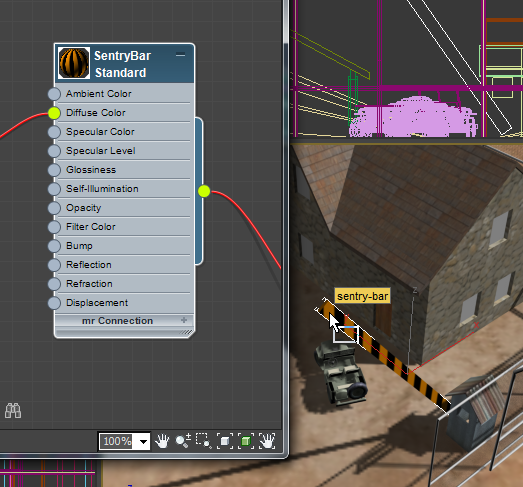
Dragging from a material node’s output socket to an object in the scene
(The wire itself is not displayed in the viewport.)
If the object isn't selected, or if it's the only object selected in the scene, the material is applied immediately. If the object is one of several selected objects in the scene, 3ds Max prompts you to choose whether to apply the material to the single object only or to the whole selection (the latter is the default choice).
 Note: You can also drag from a map node's output socket and drop on an appropriate map button (for example, Environment Map) elsewhere in the user interface.
Note: You can also drag from a map node's output socket and drop on an appropriate map button (for example, Environment Map) elsewhere in the user interface.You can also apply a material to a selection by making a selection of scene objects, selecting the material node in the active View, then clicking
 (Assign Material to Selection) on the Slate Material Editor toolbar.
(Assign Material to Selection) on the Slate Material Editor toolbar.
To remove a material from an object:
-
 Select the object.
Select the object. - In the MAXScript Listener, enter $.material=undefined.
To select objects that have the same material applied:
- In the active View, right-click the material node, then choose Select
 Select By Material.
Select By Material. 3ds Max opens a Select Objects dialog. In the list of objects, all objects with this material assigned are highlighted.
- Click Select to select those objects and close the Select Objects dialog.
When a material in the Slate Material Editor is applied to objects in the scene, you can use the Slate Material Editor to select the objects.
To add a map to the active View:
- Drag the map from the Material/Map Browser
 Maps group, or any other group, to the active View.
Maps group, or any other group, to the active View. 3ds Max places a node for the map in the active View.